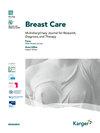HER2+早期乳腺癌:通过靶向和新辅助治疗从升级到降级
IF 2.1
4区 医学
Q2 OBSTETRICS & GYNECOLOGY
引用次数: 0
摘要
背景:人表皮生长因子受体2阳性(HER2+,也称为ERBB2+)乳腺癌是一种历史上预后特别差的亚型。对乳腺癌生物学和分子病理机制的研究导致了几种靶向HER2的治疗方法的开发和采用。同时,还研究了各种升级/降级策略,以进一步优化患者的预后和护理。摘要:在这篇综述中,我们重点介绍了HER2+早期乳腺癌治疗和管理进展中具有里程碑意义的试验。关键信息:过去二十年的持续研究逐渐延长了早期HER2+早期乳腺癌患者的生存期。将后新辅助治疗纳入临床实践可改善新辅助治疗后遗留疾病的高危患者的长期预后。与此同时,使用现代抗her2药物可能会在不影响大量选定患者生存的情况下潜在地省略化疗。目前的研究重点是探索HER2+乳腺癌的分子异质性,从而确定新的预后和预测性生物标志物,这可能为真正个性化治疗的发展铺平道路。本文章由计算机程序翻译,如有差异,请以英文原文为准。
HER2+ early breast cancer: from escalation via targeted and postneoadjuvant treatment to de-escalation
Background: Human epidermal growth factor receptor 2 positive (HER2+, also referred to as ERBB2+) breast cancer is a subtype historically associated with a particularly poor prognosis. Research into biological and molecular pathomechanisms of breast cancer has resulted in the development and adoption of several therapies targeting HER2. In parallel, various escalation/de-escalation strategies have been examined to further optimize patient outcomes and care. Summary: In this review, we highlighted the landmark trials in the evolution of treatment and management of HER2+ early breast cancer. Key Messages: Continuous research over the last two decades has gradually prolonged survival in patients with early HER2+ early breast cancer. Incorporation of post-neoadjuvant setting into clinical practice improved long-term outcomes in high-risk patients with residual disease after neoadjuvant therapy. In parallel, use of modern anti-HER2 agents may potentially allow omission of chemotherapy without compromising the survival in a significant number of selected patients. Current research focused on exploring the molecular heterogeneity of HER2+ breast cancer resulted in identification of new prognostic and predictive biomarkers which could pave the way towards the development of truly personalized therapy.
求助全文
通过发布文献求助,成功后即可免费获取论文全文。
去求助
来源期刊

Breast Care
医学-妇产科学
CiteScore
4.40
自引率
4.80%
发文量
45
审稿时长
6-12 weeks
期刊介绍:
''Breast Care'' is a peer-reviewed scientific journal that covers all aspects of breast biology. Due to its interdisciplinary perspective, it encompasses articles on basic research, prevention, diagnosis, and treatment of malignant diseases of the breast. In addition to presenting current developments in clinical research, the scope of clinical practice is broadened by including articles on relevant legal, financial and economic issues.
 求助内容:
求助内容: 应助结果提醒方式:
应助结果提醒方式:


